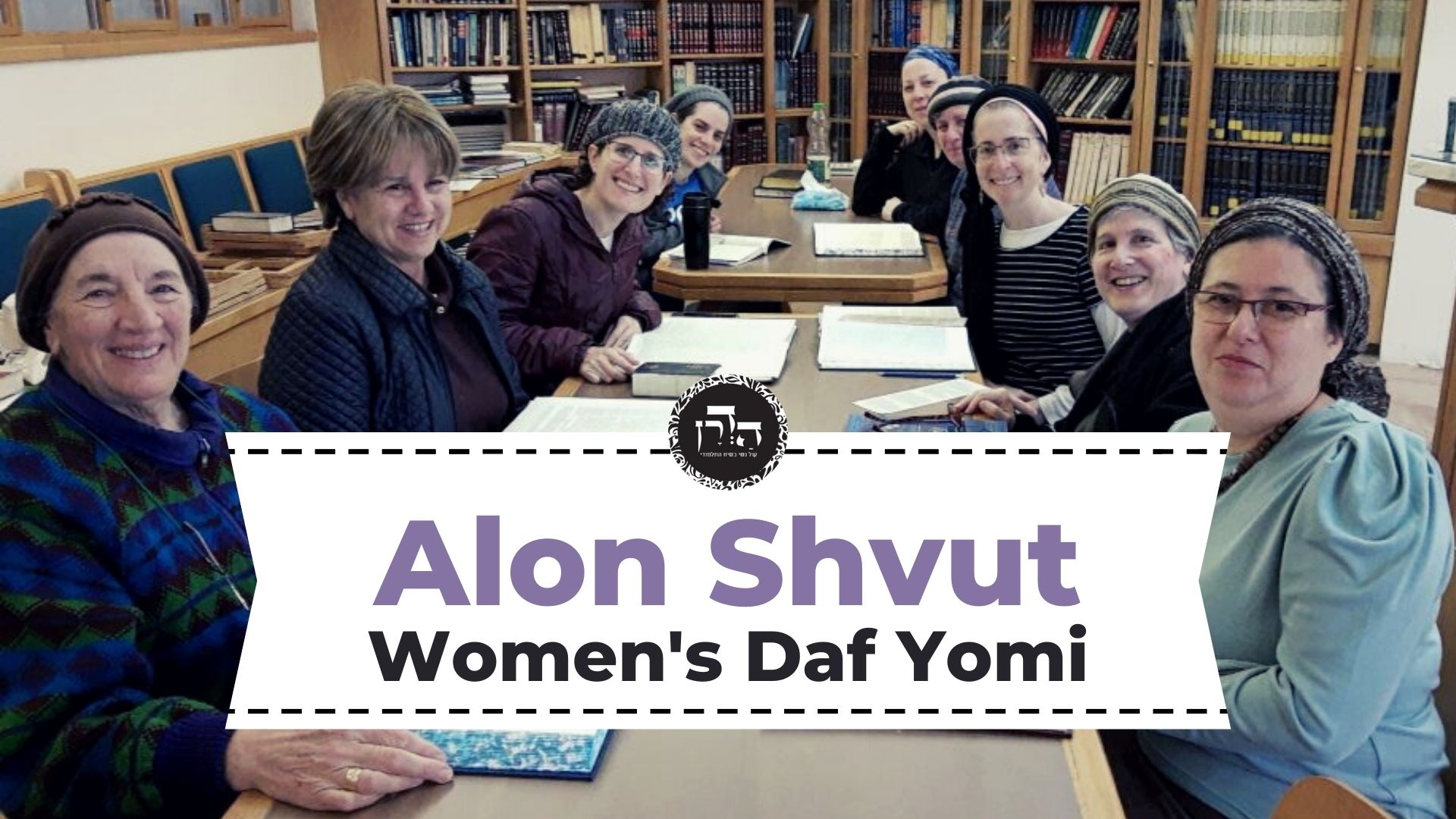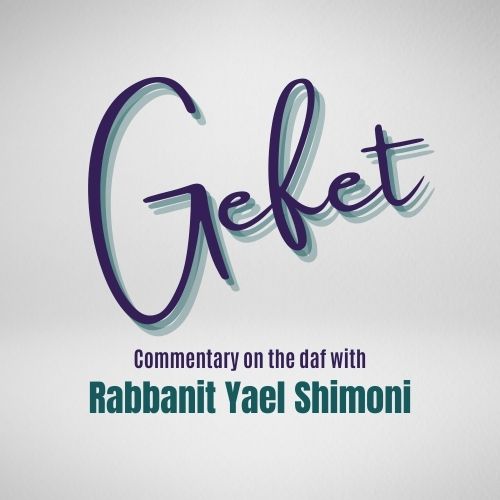Sukkah 39
מֹשֶׁה, שַׁפִּיר קָאָמְרַתְּ?! אֶלָּא הָתָם וְהָכָא אַסּוֹקֵי מִילְּתָא הִיא, וְלֵית לַן בַּהּ). אָמַר רָבָא: לָא לֵימָא אִינִישׁ ״יְהֵא שְׁמֵיהּ רַבָּא״ וַהֲדַר ״מְבָרַךְ״, אֶלָּא ״יְהֵא שְׁמֵיהּ רַבָּא מְבָרַךְ״ בַּהֲדָדֵי. אֲמַר לֵיהּ רַב סָפְרָא: מֹשֶׁה, שַׁפִּיר קָאָמְרַתְּ?! אֶלָּא, הָתָם וְהָכָא אַסּוֹקֵי מִילְּתָא הוּא, וְלֵית לַן בַּהּ.
You, who are as great in this generation as Moses, did you speak well? It is not so; rather, both there and here, whether he recites it with or without pause, the latter part of the verse is the conclusion of the matter, and we have no problem with it, as it is clear that his intention is to recite the entire verse: “Blessed is one who comes in the name of the Lord.” Rava said: Let a person not recite in the kaddish prayer: May His great name, and then, after pausing, recite: Be blessed. Rather, let him recite without pause: May His great name be blessed. Rav Safra said to Rava: You, who are as great in this generation as Moses, did you speak well? It is not so, rather, both there and here, whether he recites it with or without pause, the latter part of the verse is the conclusion of the matter, and we have no problem with it.
מָקוֹם שֶׁנָּהֲגוּ לִכְפּוֹל. תָּנָא: רַבִּי כּוֹפֵל בָּהּ דְּבָרִים. רַבִּי אֶלְעָזָר בֶּן פַּרְטָא מוֹסִיף בָּהּ דְּבָרִים. מַאי מוֹסִיף? אָמַר אַבָּיֵי: מוֹסִיף לִכְפּוֹל מֵ״אוֹדְךָ״ וּלְמַטָּה.
§ The mishna continues: In a place where they were accustomed to repeat certain verses he too should repeat them. It was taught in the Tosefta: Rabbi Yehuda HaNasi repeats certain matters in hallel. Rabbi Elazar ben Perata adds certain matters in hallel. The Gemara asks: What does he add? Abaye said: He continues repeating additional verses in hallel, those from: I will thank You, and onward until the end of the psalm, as is the custom even today.
לְבָרֵךְ — יְבָרֵךְ. אֲמַר אַבָּיֵי: לֹא שָׁנוּ אֶלָּא לְאַחֲרָיו, אֲבָל לְפָנָיו — מִצְוָה לְבָרֵךְ. דְּאָמַר רַב יְהוּדָה אָמַר שְׁמוּאֵל: כׇּל הַמִּצְוֹת כּוּלָּן, מְבָרֵךְ עֲלֵיהֶן עוֹבֵר לַעֲשִׂיָּיתָן. וּמַאי מַשְׁמַע דְּהַאי ״עוֹבֵר״, לִישָּׁנָא דְּאַקְדּוֹמֵי הוּא? דְּאָמַר רַב נַחְמָן בַּר יִצְחָק דִּכְתִיב: ״וַיָּרׇץ אֲחִימַעַץ דֶּרֶךְ הַכִּכָּר וַיַּעֲבוֹר אֶת הַכּוּשִׁי״. אַבָּיֵי אָמַר, מֵהָכָא: ״וְהוּא עָבַר לִפְנֵיהֶם״. וְאִיבָּעֵית אֵימָא מֵהָכָא: ״וַיַּעֲבוֹר מַלְכָּם לִפְנֵיהֶם וַה׳ בְּרֹאשָׁם״.
§ The mishna continues: In a place where the custom is to recite a blessing when reciting hallel, he should recite a blessing. Abaye said: The Sages taught that the obligation to recite a blessing is dependent on custom only with regard to the blessing recited after hallel. However, before hallel, there is a mitzva to recite a blessing, as Rav Yehuda said that Shmuel said: With regard to all the mitzvot, one recites a blessing over them prior to [over] their performance. The Gemara asks: From where may it be inferred that the word over is the language of priority? It is as Rav Naḥman bar Yitzḥak said that it is written: “And Ahimaaz ran by the way of the plain and overtook [vaya’avor] the Cushite” (II Samuel 18:23). Abaye said: It is derived from here: “And he passed [avar] before them” (Genesis 33:3). And if you wish, say instead that the proof is from here: “And their king passed [vaya’avor] before them and the Lord at their head” (Micah 2:13).
מַתְנִי׳ הַלּוֹקֵחַ לוּלָב מֵחֲבֵירוֹ בַּשְּׁבִיעִית — נוֹתֵן לוֹ אֶתְרוֹג בְּמַתָּנָה, לְפִי שֶׁאֵין רַשַּׁאי לְלוֹקְחוֹ בַּשְּׁבִיעִית.
MISHNA: In the case of one who purchases a lulav from another who is an am ha’aretz during the Sabbatical Year, the seller gives him an etrog along with it as a gift, as he is not permitted to purchase the etrog during the Sabbatical Year because it is prohibited to engage in commerce with Sabbatical-Year produce.
גְּמָ׳ לֹא רָצָה לִיתֵּן לוֹ בְּמַתָּנָה, מַהוּ? אָמַר רַב הוּנָא: מַבְלַיע לֵיהּ דְּמֵי אֶתְרוֹג בְּלוּלָב. וְלִיתֵּיב לֵיהּ בְּהֶדְיָא?
GEMARA: The Gemara asks: If, the seller did not want to give him the etrog as a gift, what is the halakha? How should the buyer purchase the etrog? Rav Huna said: He incorporates the cost of the etrog into the price of the lulav. He should purchase the lulav at an inflated price to cover the cost of the etrog as well. The Gemara asks: And let the buyer give the seller the money for the etrog directly; why employ artifice in the transaction?
לְפִי שֶׁאֵין מוֹסְרִין דְּמֵי פֵּירוֹת שְׁבִיעִית לְעַם הָאָרֶץ. דְּתַנְיָא: אֵין מוֹסְרִין דְּמֵי פֵּירוֹת שְׁבִיעִית לְעַם הָאָרֶץ יוֹתֵר מִמְּזוֹן שָׁלֹשׁ סְעוּדוֹת. וְאִם מָסַר, יֹאמַר: הֲרֵי מָעוֹת הַלָּלוּ יְהוּ מְחוּלָּלִין עַל פֵּירוֹת שֶׁיֵּשׁ לִי בְּתוֹךְ בֵּיתִי,
The Gemara answers: That is necessary because one may not transfer money used to purchase Sabbatical-Year produce to an am ha’aretz, lest he make improper use of money that has sanctity of the Sabbatical Year. As it is taught in a baraita: One may not transfer to an am ha’aretz money used to purchase Sabbatical-Year produce that is worth more than the value of food sufficient for three meals. One may use money that has sanctity of the Sabbatical Year to purchase food for his personal use. If the money is sufficient for three meals, presumably the seller will use it in a permitted manner. And if the buyer transferred more money than that, he should say: This money is deconsecrated by my redeeming it in exchange for non-Sabbatical-Year produce that I have in my house.
וּבָא וְאוֹכְלָן בִּקְדוּשַּׁת שְׁבִיעִית.
And then he comes home and eats the produce in the appropriate manner and at the appropriate time, due to the sanctity of Sabbatical-Year produce.
בַּמֶּה דְּבָרִים אֲמוּרִים — בְּלוֹקֵחַ מִן הַמּוּפְקָר. אֲבָל בְּלוֹקֵחַ מִן הַמְשׁוּמָּר, אֲפִילּוּ בְּכַחֲצִי אִיסָּר — אָסוּר.
The baraita continues: In what case is this statement said that it is permitted to transfer money used to purchase Sabbatical-Year produce to an am ha’aretz as long as it does not exceed the value of three meals? It is specifically in a case where one purchases produce that came from a field that was declared ownerless as required during the Sabbatical Year. In that case, the am ha’aretz who gathered the produce is paid only for the act of harvesting and not for the produce. However, if he buys produce that came from a field that was safeguarded for its owner in the manner that it is during the other years of the Sabbatical-Year cycle and was not declared ownerless, then even if one purchased produce worth half an issar, it is prohibited to transfer the money to him, as it is prohibited to utilize fruits that were safeguarded during the Sabbatical Year.
מֵתִיב רַב שֵׁשֶׁת: וּמִן הַמּוּפְקָר שָׁלֹשׁ סְעוּדוֹת וְתוּ לָא? וּרְמִינְהִי: הַפֵּיגָם וְהַיַּרְבּוּזִין וְהַשֵּׁיטִים וַחֲלֹגְלוֹגוֹת וְהַכּוּסְבָּר שֶׁבֶּהָרִים וְהַכַּרְפַּס שֶׁבַּנְּהָרוֹת וְהַגַּרְגִּיר שֶׁל אֲפָר — פְּטוּרִין מִן הַמַּעֲשֵׂר, וְנִיקָּחִין מִכׇּל אָדָם בַּשְּׁבִיעִית, לְפִי שֶׁאֵין כַּיּוֹצֵא בָּהֶן נִשְׁמָר.
Rav Sheshet raised an objection: And is it permitted to purchase produce from an ownerless field worth only the value of three meals and no more? He raised a contradiction from a mishna (Shevi’it 9:1): Rue and sorrel, two types of herbs, and vegetables such as asparagus, purslane, coriander that is found in the mountains, water parsley of the rivers, and garden-eruca are all exempt from the requirement of tithes in all years, and they may be purchased from any person during the Sabbatical Year because there is no plant of their species that is safeguarded. These plants are not cultivated but grow wild, rendering them ownerless. Apparently, these plants that grow wild may be purchased in any quantity, even from an am ha’aretz, with no three-meal limit.
הוּא מוֹתֵיב לַהּ וְהוּא מְפָרֵק לַהּ: בִּכְדֵי מָן שָׁנוּ. וְכֵן אָמַר רַבָּה בַּר בַּר חָנָה אָמַר רַבִּי יוֹחָנָן: בִּכְדֵי מָן שָׁנוּ. מַאי מַשְׁמַע דְּהַאי ״מָן״ לִישָּׁנָא דִּמְזוֹנֵי הוּא — דִּכְתִיב: ״וַיְמַן לָהֶם הַמֶּלֶךְ וְגוֹ׳״.
The Gemara continues. Rav Sheshet raised the objection, and he also resolved it: The Sages taught this halakha in the mishna with regard to food in the amount sufficient for his sustenance [man]. These plants that the mishna excludes from the prohibition against purchase from an am ha’aretz are still subject to the three-meal limit. And likewise, Rabba bar bar Ḥana said that Rabbi Yoḥanan said: The Sages taught this halakha in the amount sufficient for his sustenance [man]. From where may it be inferred that man is a term meaning sustenance? It is as it is written: “And the king appointed [vayman] for them a daily portion of the king’s food” (Daniel 1:5).
אִי הָכִי, לוּלָב נָמֵי! לוּלָב בַּר שִׁשִּׁית הַנִּכְנָס לִשְׁבִיעִית הוּא. אִי הָכִי אֶתְרוֹג נָמֵי — בַּת שִׁשִּׁית הַנִּכְנֶסֶת לִשְׁבִיעִית הִיא! אֶתְרוֹג, בָּתַר לְקִיטָה אָזְלִינַן.
§ The Gemara asks: If so, if one may not purchase produce from an am ha’aretz lest he misuse the money, it should also be prohibited to give him money and purchase a lulav from him during the Sabbatical Year. The Gemara answers: The mishna is dealing with a case where the lulav is of the sixth year that is entering the seventh year. As it grew during the sixth year, it is permitted, even though it was removed from the tree during the seventh year. The fact that it remained on the tree between Rosh HaShana and Sukkot does not render it Sabbatical-Year produce. The Gemara objects: If so, the etrog, too, is an object of the sixth year that is entering the seventh year and should have the same status. The Gemara answers: With regard to an etrog, as opposed to a lulav, in determining its status we go according to its picking and not when it grew. Therefore, in that case, the etrog is considered to be Sabbatical-Year produce.
וְהָא בֵּין רַבָּן גַּמְלִיאֵל וּבֵין רַבִּי אֱלִיעֶזֶר, לְעִנְיַן שְׁבִיעִית אֶתְרוֹג בָּתַר חֲנָטָה אָזְלִינַן! דִּתְנַן: אֶתְרוֹג שָׁוֶה לָאִילָן בִּשְׁלֹשָׁה דְּרָכִים, וְלַיָּרָק בְּדֶרֶךְ אֶחָד.
The Gemara objects: But both Rabban Gamliel and Rabbi Eliezer, who disagree about the status of an etrog that grew in one year and was picked in the following year in terms of determining its year for the halakhot of tithing, agree with regard to the halakhot of the Sabbatical Year that with regard to an etrog we go according to its ripening, as we learned in a mishna (Bikkurim 2:6): The halakhic status of the fruit of an etrog tree is like that of a typical fruit tree in three manners and like that of a vegetable in one manner.
שָׁוֶה לָאִילָן בִּשְׁלֹשָׁה דְּרָכִים — לְעׇרְלָה וְלִרְבָעִי וְלִשְׁבִיעִית. וּלְיָרָק בְּדֶרֶךְ אֶחָד —
The mishna elaborates: Its halakhic status is like that of a tree in three manners: With regard to orla, i.e., it is prohibited to eat of its fruit during the first three years after its planting; with regard to fourth-year produce, i.e., fruits that grow during the fourth year after the tree’s planting, which may not be used outside of Jerusalem unless they are deconsecrated by means of redemption; and with regard to the Sabbatical Year. With regard to all those halakhot, the year to which the fruit is ascribed is determined by when it ripens. And its halakhic status is like that of a vegetable in one manner:
























